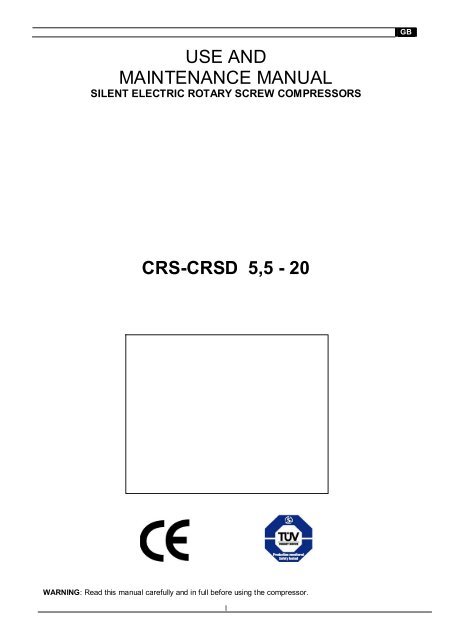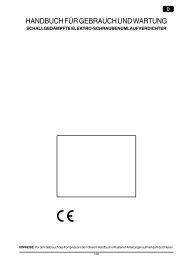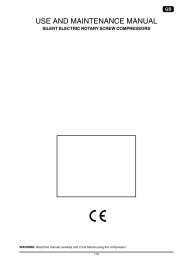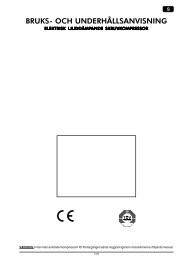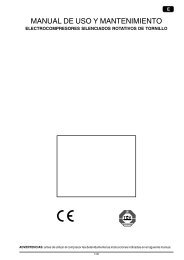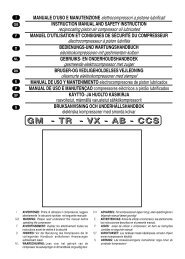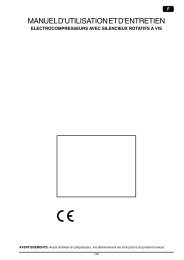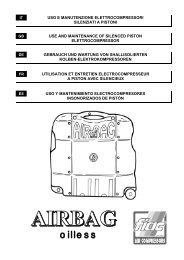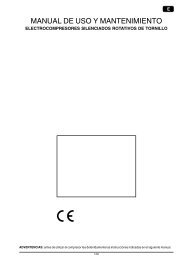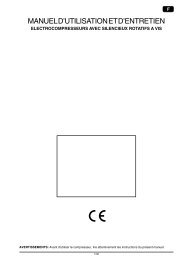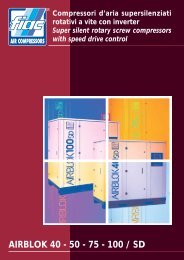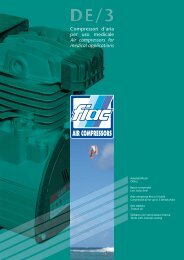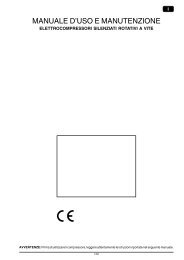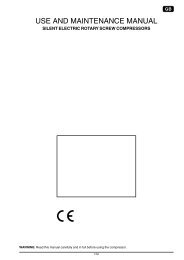USE AND MAINTENANCE MANUAL CRS-CRSD 5,5 - 20
USE AND MAINTENANCE MANUAL CRS-CRSD 5,5 - 20
USE AND MAINTENANCE MANUAL CRS-CRSD 5,5 - 20
You also want an ePaper? Increase the reach of your titles
YUMPU automatically turns print PDFs into web optimized ePapers that Google loves.
GB<strong>USE</strong> <strong>AND</strong><strong>MAINTENANCE</strong> <strong>MANUAL</strong>SILENT ELECTRIC ROTARY SCREW COMPRESSORS<strong>CRS</strong>-<strong>CRS</strong>D 5,5 - <strong>20</strong>WARNING: Read this manual carefully and in full before using the compressor.1
GBIMPORTANT INFORMATIONRead all the operational instructions, safety recommendations and all warnings provided in the instructionmanual.Most accidents encountered when using the compressor are merely due to the failed observance of basicsafety standards.Accidents are prevented by foreseeing potentially hazardous situations and observing the appropriate safetystandards.The fundamental safety standards are listed in the “SAFETY” section of this manual and also in the sectioninvolving the use and maintenance of the compressor.Hazardous situations to be avoided in order to prevent serious personal injuries and machine damages arelisted in the “WARNINGS” section of the instruction manual or are actually printed on the machine.Never use the compressor improperly but only as recommended by the Manufacturer.The Manufacturer reserves the right to up-date the technical information given in this manual without notice.2
GBIIndex0 Foreword.............................................................................................. 50.1 How to read and use the instruction manual............................................ 50.1.a Importance of the manual...............................................................................................50.1.b Conserving the manual...................................................................................................50.1.c Consulting the manual ...................................................................................................50.1.d Symbols used.................................................................................................................61 General information ........................................................................... 71.1 Identification data of the manufacturer and the compressor................... 71.2 Information on machine technical/maintenance service.......................... 71.3 General safety warnings............................................................................ 82 Preliminary machine information .................................................. 112.1 General description..................................................................................112.2 Intended use.............................................................................................112.3 Technical data ..........................................................................................123 Transport, Handling, Storage ......................................................... 133.1 Transporting and handling the packed machine.....................................133.2 Packing and unpacking............................................................................133.3 Storing the packed and unpacked compressor.......................................144 Installation ......................................................................................... 154.1 Admitted surrounding conditions............................................................154.2 Space required for maintenance..............................................................154.3 Positioning the compressor.....................................................................164.4 Connecting the compressor to the sources of energy and relativeinspections .......................................................................................................174.4.1 Connecting the compressor to the electrical mains power supply............................... 174.4.2 Connecting the dryer to the electrical mains ................................................................ 194.4.3 Connecting to the pneumatic mains (compressor a on the ground)............................. <strong>20</strong>4.4.4 Connecting to the pneumatic mains (compressor with tank) ....................................... <strong>20</strong>5 Using the compressor ..................................................................... 215.1 Preparing to use the compressor ............................................................215.1.1 Operational principle .................................................................................................... 215.1.2 Tank.............................................................................................................................. 215.2 Controls, indicators and safety devices of the compressor ...................225.2.1 Control panel................................................................................................................ 225.2.2 Display.......................................................................................................................... 235.2.3 Auxiliary control devices .............................................................................................. 265.3 Check the efficiency of the safety devices before starting .....................263
GB5.4 Starting the compressor...........................................................................265.5 Stopping the compressor.........................................................................276 Using the dryer ................................................................................. 286.1 Preparing to use the dryer .......................................................................286.1.1 Operational principle .................................................................................................... 286.2 Condensate discharge .............................................................................296.3 Dryer safety devices.................................................................................296.4 Controls and indicators............................................................................296.4.1 Control panel................................................................................................................ 296.4.2 By-pass ........................................................................................................................ 316.4.3 Air inlet and outlet filters .............................................................................................. 317 Compressor maintenance............................................................... 327.1 Instructions relative to inspections and maintenance jobs. ...................327.1.1 Changing the oil ........................................................................................................... 357.1.2 Replacing the oil filter cartridge ................................................................................... 367.1.3 Replacing the filter cartridge of the oil separator ......................................................... 367.1.4 Replacing the air filter cartridge ................................................................................... 377.1.5 Tightening the belt........................................................................................................ 377.1.6 Replacing the belt ........................................................................................................ 377.1.7 Draining the condensate (only for models equipped with tank) ................................... 387.1.8 Cleaning the air/oli radiator .......................................................................................... 387.1.9 Cleaning the dust-removal pre-filter ............................................................................. 397.1.10 Lubricating the electric motor ...................................................................................... 397.2 Diagnosing the alarm status/inconveniences-faults ...............................408 Dryer maintenance ........................................................................... 428.1 Instructions relative to inspections/maintenance jobs ...........................428.1.1 Checking if the air inlet and outlet filters are clogged .................................................. 438.1.2 Cleaning the condenser................................................................................................ 438.1.3 Cleaning the mechanical filter ...................................................................................... 438.2 Diagnosing alarm status/inconveniences-faults .....................................449 Drawings and diagrams................................................................... 459.1 Wiring diagrams .......................................................................................459.2 Pneumatic diagrams.................................................................................49Maintenance schedule4
GB0 Foreword0.1 How to read and use the instruction manual0.1.aImportance of the manualThis INSTRUCTION <strong>MANUAL</strong> has been written to guide you through the INSTALLATION, <strong>USE</strong>and <strong>MAINTENANCE</strong> of the compressor purchased.We recommend that you strictly observe all the indications given within as the ideal operationalefficiency and lasting wear of the compressor depend on the correct use and methodicalapplication of the maintenance instructions given hereafter.Remember that when any doubts or inconveniences arise it is a good rule to always contact theAUTHORISED SERVICE CENTRES. They are at your complete disposal for any explanations orjobs required.The Manufacturer therefore declines all liabilities regarding the incorrect use and poormaintenance of the compressor.The INSTRUCTION <strong>MANUAL</strong> is integral part of the compressor.Ensure that any up-dates forwarded by the Manufacturer are actually added to the manual.If the compressor is sold on at a later date the manual must be given to the new owner.0.1.bConserving the manualUse and read the manual with care being careful not to damage any part of it.Do not remove, tear or re-write any parts of the manual for any reason whatsoever.Keep the manual in a dry and sheltered place.0.1.cConsulting the manualThis instruction manual is made up of the following:• FRONT COVER WITH MACHINE IDENTIFICATION• DETAILED INDEX• INSTRUCTIONS <strong>AND</strong>/OR NOTES ON THE COMPRESSORThe model and serial number of the compressor to which the manual refers and that you havepurchased is found on the FRONT COVER.The various SECTIONS in which all the notes relative to a certain subject are found in the INDEX.All the INSTRUCTIONS <strong>AND</strong>/OR NOTES ON THE COMPRESSOR aim at pointing out safetywarnings and procedures required to use the compressor correctly.5
GB0.1.dSymbols usedThe SYMBOLS pointed out below are used throughout this manual and their purpose is that ofdrawing the operator’s attention, informing the latter how to behave and how to proceed in eachoperational situation.READ THE INSTRUCTION <strong>MANUAL</strong>Read the use and maintenance manual carefully before installing and starting thecompressor.GENERAL HAZARDOUS SITUATIONAn additional note will point out the type of hazard involved.Meaning of the indications:Warning!Note!This points out a potentially hazardous situation, which if ignored, could causepersonal injury and machine damage.This enhances crucial information.RISK OF ELECTRIC SHOCKWarning: the electrical power supply of the compressor must be disconnectedbefore doing any jobs on the compressor.RISK OF SCOLDINGWarning: be careful when touching the compressor as some parts of it could bevery hot.6
GB1 General information1.1 Identification data of the manufacturer and the compressorCOMPRESSORIDENTIFICATIONNAMEPLATE (Example)Silent electric rotary screwcompressorSilent electric rotary screw compressor fitted on atank and inclusive of air dryer whit refrigerationcircuit and filter.Silent electric rotary screw compressor fittedon a tank1.2 Information on machine technical/maintenance serviceWe remind you that our technical service department is at your complete disposal to help youresolve any problems that may possibly be encountered, or to provide you with any otherinformation necessary.In the case of need contact:Our CUSTOMER TECHNICAL SERVICE department or your local dealer.7
GBThe constant and efficient performance of the compressor is ensured only if original spare parts areused.We recommend therefore that you strictly observe the indications provided in the <strong>MAINTENANCE</strong>section and to use EXCLUSIVELY original spare parts.The use of NON ORIGINAL spare parts automatically annuls the guarantee.1.3 General safety warningsNote!The procedures provided in this manual have been written to assist theoperator throughout the use and maintenance of the compressor.IMPORTANT INSTRUCTIONS FOR THE SAFE <strong>USE</strong> OF THE COMPRESSORWARNING: THE INAPPROPRIATE <strong>USE</strong> <strong>AND</strong> POOR <strong>MAINTENANCE</strong> OF THIS COMPRESSORMAY CA<strong>USE</strong> PHYSICAL INJURY TO THE <strong>USE</strong>R. YOU ARE RECOMMENDED TO CAREFULLYFOLLOW THE INSTRUCTIONS PROVIDED HEREAFTER TO AVOID SUCH RISKS.1. DO NOT TOUCH MOVING PARTSNever put your hands, fingers or other parts of the body near moving parts of the compressor.2. NEVER <strong>USE</strong> THE COMPRESSOR WITHOUT THE SAFETY GUARDS FITTEDNever use the compressor without all the safety guards fitted perfectly in their correct place (i.e.panelling, belt guard, safety valve). If these parts are to be removed for maintenance or servicingpurposes, ensure that they are put back in their original place perfectly before using thecompressor again.3. ALWAYS WEAR SAFETY GOGGLESAlways wear goggles or equivalent eye protection means. Never direct compressed air towardsany part of your body or that of others.4. PROTECT YOURSELF AGAINST ELECTRIC SHOCKSAvoid accidentally touching the metal parts of the compressor with your body, such as pipes, thetank or metal parts connected to earth. Never use the compressor where there is water or in damprooms.5. DISCONNECT THE COMPRESSORDisconnect the compressor from the electric power supply and completely discharge the pressurefrom the tank before carrying out any service, inspection, maintenance, cleaning, replacing orinspection jobs of each part.6. ACCIDENTAL START-UPNever move the compressor while it is connected to the electrical power supply or when the tank ispressurised. Ensure that the main switch is turned OFF before connecting the compressor to theelectrical power supply.7. STORE THE COMPRESSOR APPROPRIATELYWhen the compressor is not in use, it must be stored in a dry room away from atmospheric agents.Keep it out of children’s reach.8. OPERATIONAL AREAKeep the work area clean and remove any tools that are not required. Keep the work areasufficiently ventilated. Never use the compressor in the presence of flammable liquids or gas. Thecompressor may produce sparks while running. Do not use the compressor where there may bepaints, gasoline, chemical compounds, glues and any other flammable or explosive material.9. KEEP THE COMPRESSOR OUT OF CHILDREN’S REACHPrevent children or anyone else from touching the power supply cable of the compressor. Alloutsiders must be kept at a safe distance from the operational area.10. WORK CLOTHESDo not wear unsuitable clothing, ties or jewellery as these may get caught up in moving parts.Wear caps to cover your hair if necessary.11. PRECAUTIONS FOR THE POWER SUPPLY CABLEDo not disconnect the power supply plug by pulling on the cable. Keep the cable away from heat,oil and sharp edges. Do not stand on the electrical cable or squash it under heavy weights.8
12. LOOK AFTER THE COMPRESSOR WITH CAREFollow the maintenance instructions. Inspect the power supply cable on a periodic basis and ifdamaged it must be repaired or replaced by an authorised service centre. Visually check theoutside appearance of the compressor, ensuring that there are no visual anomalies. Contact yournearest service centre if necessary.13. ELECTRICAL EXTENSIONS FOR OUTDOOR <strong>USE</strong>When the compressor is used outdoors, use only electrical extensions manufactured for outdooruse and marked as such.14. WARNINGPay attention to everything you do. Use your common sense.Do not use the compressor if you are tired. The compressor must never be used if you are underthe effect of alcohol, drugs or medicines, which could make you tired.15. CHECK FAULTY PARTS OR AIR LEAKSBefore using the compressor again, if a safety guard or other parts are damaged, they must bechecked carefully to evaluate whether they may operate as established in complete safety.Check the alignment of moving parts, hoses, gauges, pressure reducers, pneumatic connectionsand every other part that may be crucial for the normal operational efficiency of the compressor. Alldamaged parts must be properly repaired or replaced by an authorised service centre or replacedfollowing the instructions provided in instruction manual.16. <strong>USE</strong> THE COMPRESSOR EXCLUSIVELY FOR THE APPLICATIONS SPECIFIED IN THISINSTRUCTION <strong>MANUAL</strong>.The compressor is a machine that produces compressed air.Never use the compressor for purposes other than those specified in the instruction manual.17. <strong>USE</strong> THE COMPRESSOR CORRECTLYOperate the compressor in compliance with the instructions provided in this manual. Do not allowchildren to use the compressor or those who are not familiar with it.18. ENSURE THAT EACH SCREW, BOLT <strong>AND</strong> GUARD IS FIRMLY SECURED IN PLACE.19. KEEP THE IN-TAKE GRIDS CLEANKeep the motor ventilation grids clean. Regularly clean these grids if the work area is particularlydirty.<strong>20</strong>. OPERATE THE COMPRESSOR AT THE RATED VOLTAGEOperate the compressor at the voltage specified on the electric data plate. You could damage orburn-out the motor and other electric components if the compressor is operated at a higher or lowervoltage than its rated voltage.21. NEVER <strong>USE</strong> THE COMPRESSOR IF IT IS FAULTYIf the compressor is noisy or vibrates excessively when running or it seems to be faulty, stop itimmediately and check its efficiency or contact your nearest authorised service centre.22. DO NOT CLEAN PLASTIC PARTS USING SOLVENTSSolvents such as gasoline, thinners, gas oil or other compounds that contain hydrocarbons maydamage the plastic parts. Clean them with a soft cloth and soapy water or other suitable liquids.23. <strong>USE</strong> ORGINAL SPARE PARTS ONLYThe use of non-original spare parts involves the annulment of the guarantee and the abnormalrunning conditions of the compressor. Original spare parts are available c/o the authorised dealers.24. DO NOT MODIFY THE COMPRESSORDo not modify the compressor. Contact an authorised service centre for all repairs required. Anunauthorised modification may impair the efficiency of the compressor and may also cause seriousaccidents for those who do not have the technical skill required to make such modifications.25. TURN THE COMPRESSOR OFF WHEN IT IS NOT IN <strong>USE</strong>When the compressor is not in use turn the main ON/OFF switch OFF (position “0”).26. DO NOT TOUCH HOT PARTS OF THE COMPRESSORTo avoid scolding do not touch pipes, the motor or any other hot part.27. DO NOT DIRECT THE JET OF AIR DIRECTLY TOWARDS THE BODYTo avoid all risks never direct the jet of air towards people or animals.28. DO NOT STOP THE COMPRESSOR BY PULLING ON THE POWER SUPPLY CABLEUse the “O/I” (ON/OFF) buttons of the control panel to stop the compressor.29. PNEUMATIC CIRCUITUse recommended pneumatic hoses and tools that can withstand the same or a higher pressurethan the maximum running pressure of the compressor.30. SPARE PARTSUse only original and identical spare parts to replace worn or damaged ones.Repairs must be made exclusively by authorised service centres.31. CORRECT <strong>USE</strong> OF THE COMPRESSOR9GB
GBThe operator must be perfectly familiar with all the controls and compressor characteristics beforestarting to work with the machine.32. <strong>MAINTENANCE</strong> JOBSThe use and maintenance jobs of the commercial components fitted on the machine, but notindicated in this manual, are indicated in the enclosed documents.33. DO NOT UNSCREW THE CONNECTION WHEN THE TANK IS PRESSURISEDDo not unscrew the connection for any reason whatsoever with the tank pressurised without firstchecking if the tank is discharged.34. DO NOT MODIFY THE TANKIt is prohibited to intentionally drill, weld or deform the compressed air tank.35. IF THE COMPRESSOR IS <strong>USE</strong>D FOR PAINTING JOBSa) Do not work in closed rooms or near free flames.b) Ensure that the room in which you are working is sufficiently ventilated.c) Wear face and nose mask.36.DO NOT PUT OBJECTS OR PARTS OF THE BODY IN THE PROTECTION GRIDSDo not put objects or parts of the body in the protection grids to prevent physical injuries anddamage to the compressor.KEEP THESE <strong>USE</strong> <strong>AND</strong> <strong>MAINTENANCE</strong> INSTRUCTIONS CAREFULLY <strong>AND</strong>GIVE THEM TO PERSONNEL WISHING TO <strong>USE</strong> THE COMPRESSOR!WE RESERVE THE RIGHT TO MAKE MODIFICATIONS WHERE NECESSARYWITHOUT NOTICE10
GB2 Preliminary machine information2.1 General descriptionThe rotary screw compressor has been specifically designed aiming at minimising maintenanceand labour costs.The outside cabinet is completely covered in sound-proof and oil-proof panelling thus ensuring itsextended and lasting wear.The components have been arranged so that all vital parts can be easily reached for maintenancepurposes simply by opening dedicated panels with quick-release locking devices.The filters and adjustment and safety devices (oil filter, air filter, oil separator filter, regulator valve,minimum pressure valve, max. pressure safety valve, thermostat, belt tightener, screwcompression unit, pressure switch and oil separator tank emptying and filling taps) are all fitted onthe same side.The dryer series has been devised with the intention of enclosing a complete compressed airsystem in one compact machine. It is indeed connected to a dryer that is capable of supplying dryair to ensure the perfect and lasting use of the tools.Note!Note!The tanks of the compressors have been manufactured in compliance withthe EEC/404/87 Directive for the European market.The compressors have been manufactured in compliance with the EC/37/98Directive for the European market.Check your model on the identification nameplate fitted on the compressor.It is also indicated in this manual.ADVISED LUBRICANTSAlways use oil for turbines with approximately 46 cSt at 40°C and a pour point of at least -8 +10°C.The flash point must be greater than +<strong>20</strong>0°C.NEVER MIX DIFFERENT OIL QUALITIES.SCREW OILESSO EXXCOLUB 46BP ENERGOL HLP 46SHELL CORENA D 46TOTAL AZOLLA ZS 46MOBIL DTE OIL 25DUCKHAMS ZIRCON 46Use oil with VG32 rating for cold climates and VG68 for tropical climates.It is advisable to use synthetic oils for very hot and humid climates.2.2 Intended useThe silent rotary screw compressors have been designed and manufactured exclusively toproduce compressed air.EVERY OTHER <strong>USE</strong>, DIFFERENT <strong>AND</strong> NOT FORESEEN BY ALL INDICATED, RELIEVES THEMANUFACTURER OF POSSIBLE CONSEQUENT RISKS.In any event the use of the compressor different to that agreed in the purchase order RELIEVESTHE MANUFACTURER FROM ALL LIABILITIES WITH REGARD TO POSSIBLE MATERIALDAMAGE <strong>AND</strong> PERSONAL INJURY.The electrical system is not designed for the use in environments subject to explosion or forflammable products.NEVER DIRECT THE JET OF AIR TOWARDS PEOPLE OR ANIMALS. NEVER<strong>USE</strong> THE COMPRESSED AIR PRODUCED BY LUBRICATED COMPRESSORSFOR RESPIRATORY PURPOSES OR IN PRODUCTION PROCESSES WHERETHE AIR IS IN DIRECT CONTACT WITH FOODSTUFFS UNLESS IT HAS BEENFIRST FILTERED <strong>AND</strong> CONDITIONED FOR SUCH PURPOSE.11
GB2.3 Preliminary machine informationHpi7.5ModelHPi5.5Hpi10Max pressureType of rotary screwBar/psi 8-116 10-145 8-116 10-145NK40NK4013-188 8-116 10-145 13-188NK40Compressor rotationmin¹3610 2740 4840 4150 3260 6610 6180 4940Free air delivery ISOl/min550 4<strong>20</strong> 790 650 530 1050 950 780cfm19,4 15 27,8 22,9 18,7 37,06 33,5 27,5Air outlet fittingR3/4 G 3/4 G 3/4 G 3/4 G 3/4 G 3/4 G 3/4 G 3/4 GLubricant q.ty3 3 3 3 3 3 3 3Fan capacitym³/h1500 1500 1500 1500 1500 2<strong>20</strong>0 2<strong>20</strong>0 2<strong>20</strong>0< 3Oil residue in air ppm< 3 < 3 < 3 < 3 < 3 < 3 < 32 pole electric motor IEC MEC112 MEC112 MEC112 MEC112 MEC112 MEC112 MEC112 MEC112OutputHP/kW 5,5/4 5,5/4 7,5/5,5 7,5/5,5 7,5/5,5 10/7,5 10/7,5 10/7,5Protection rating IP54 54 54 54 54 54 54 54ServiceS 1 S 1 S 1 S 1 S 1 S 1 S 1 S 1Max. starts per hourAmbient temperatureN°(min/max)105/45105/45105/45105/45105/45105/45105/45105/45Noise leveldB (A) 66 66 67 67 67 67 67 67Sound level measured in a free range at a dinstance of 4 m: ±3 dB(A) at the maximum working pressure.Note: the tecnical data and dimensions of the machine are subject to variations at any time without notice.8-11662701530543/4 G32650< 3MEC11215/1154S 1105/4568Hpi1510-14513-188NK60601050101380110048,738,83/4 G3/4 G3326502650< 3< 3MEC112MEC11215/1115/115454S 1S 110105/455/45686816-232440010<strong>20</strong>363/4 G32650< 3MEC11215/1154S 1105/45688-1167780<strong>20</strong>5072,33/4 G54100< 3MEC112<strong>20</strong>/1554S 1105/4569Hpi<strong>20</strong>10-145NK607190180560,013/4 G54100< 3MEC112<strong>20</strong>/1554S 1105/456913-1886365146051,53/4 G54100< 3MEC112<strong>20</strong>/1554S 1105/4569I12
GB3 Transport, Handling, StorageIn order to use the compressor in complete safety read the safety standardsgiven in section 1.3. before reading this section.3.1 Transporting and handling the packed machineThe packed compressor must be transported by qualified personnel using aforklift truck.Before moving the machine ensure that the load-bearing capacity of the forklift truck is sufficient totake the weight to be lifted.Position the forks exclusively as illustrated below. Once the forks have been positioned in thepoints indicated, lift slowly without jerking.Never stand near the area where the compressor is being handled and neverstand on the crate while it is being moved.3.2 Packing and unpackingTo avoid damages and to protect the compressor during transport it is usually placed on a woodenpallet, to which it is secured by screws and covered with cardboard.All the shipping and handling information and symbols are printed on the compressor packing.Upon consignment remove the top part of the packing and check if any damages have beenencountered during transport. If any damages are found, caused during transport, immediatelymake a written claim, backed up with photos of the damaged parts if possible and forwardeverything to your insurance company, with copy to the Manufacturer and transporter.13
GBUsing a forklift truck take the compressor as near as possible to the place where it is to be installedthen carefully remove the protective packing without damaging it, following the instructions below:• Remove the packing 1, by sliding it away upwards.• Unscrew screws 2 that block the feet that secure the compressor to the pallet (only for modelswith tank).Note!The compressor can be left on the packing pallet to make it easier to move.Carefully ensure that the contents correspond with all written in the consignment documents.Dispose of the packing in compliance with current standards in force in the country of installation.Note!The machine must be unpacked by qualified personnel using appropriatetools and equipment.3.3 Storing the packed and unpacked compressorFor the whole time that the compressor is not used before unpacking it, store it in a dry place at atemperature between +5°C and + 45°C and sheltered away from weather.For the whole time that the compressor is not used after unpacking it, while waiting to start it up ordue to production stoppages, place sheets over it to protect it from dust, which may settle on thecomponents.The oil is to be replaced and the operational efficiency of the compressor is to be checked if it is notused for long periods.14
GB4 InstallationIn order to use the compressor in complete safety read the safety standardsgiven in section 1.3. before reading this section.4.1 Admitted surrounding conditionsPosition the machine as established when the order was placed. Failing this the Manufacturer isnot liable for any inconveniences that may possibly arise.Unless pointed out otherwise when placing the order, the compressor must work regularly in thesurrounding conditions indicated below:ROOM TEMPERATUREThe room temperature must not be lower than 5°C or higher than 45°C to ensure the idealoperational efficiency of the compressor.If the compressor works at a room temperature lower than the minimum value, the condensatecould be separated within the circuit and therefore the water would mix with the oil, thusdeteriorating the quality of the latter, failing to guarantee the even formation of the lubricating filmbetween the moving parts with the possibility of seizure.If the compressor works at a room temperature higher than maximum value, the compressor wouldtake in air that is too hot, which would prevent the heat exchanger from adequately cooling the oilin the circuit, raising the working temperature of the machine, thus causing the thermal safetydevice to trip, which stops the compressor due to an excessive temperature of the air/oil mixture atthe screw outlet.The maximum temperature of the room is to be measured while the compressor is running.LIGHTINGThe compressor has been designed in compliance with legal prescriptions and in the attempt tominimise shadow zones to facilitate the operator’s job.The lighting system of the factory is to be considered as crucial for the operator’s safety.The room in which the compressor is installed must have no shadow zones, dazzling lights orstroboscopic effects due to the lighting.ATMOSPHERE WITH RISK OF EXPLOSION <strong>AND</strong>/OR FIREThe standard compressor is not pre-arranged or designed to work in rooms subject to the risk ofexplosion or fire. The performance of the compressor may decrease at the maximum permittedambient temperature, with relative humidity higher than 80% and at an altitude of more than 1,000mt.4.2 Space required for maintenanceThe compressor must be installed in a large room that is well-aired, dust-free and sheltered awayfrom rain and frost. The compressor takes in a large amount of air that is required to ventilate itinternally. A dusty atmosphere would in time cause damages and inefficient performance.Part of the dust once inside is taken in by the air filter causing it to clog rapidly and another part ofdust will settle on the components and will be blown against the cooling radiator, consequentlycompromising the efficiency of the heat exchanger. It is therefore obvious that the cleanliness ofthe area in which the compressor is installed is crucial for the correct efficiency of the machine,avoiding excessive running and maintenance costs. To facilitate maintenance jobs and to create afavourable circulation of air, the compressor must have a sufficient free space all around it (seefig.).15
GBThe room must be provided with outlets that lead outdoors near the floor and ceiling that will allowthe natural circulation of air. If this is not possible, install some fans or extractors that guarantee ahigher air flow rate than that taken in by the compressor.Ducts for the inlet and outlet of the air can be used in unfavourable environments. These ductsmust be the same size as the in-take and delivery grid. If these ducts are longer than 3 meterscontact the Authorised Service Centre.Note! A conveyance system can be fitted to recover the hot ventilation air delivered, whichcan be used to heat the room or for other purposes. It is crucial that the cross section ofthe system that recovers the hot air is greater than the total cross section of the grid slotsplus the system must be equipped with a forced extraction system (extractor fan) to favoura constant downflow.4.3 Positioning the compressorOnce the position in which the compressor is to be installed has been identified ensure that thecompressor is set on a flat surface.The dryer versions are already internally pre-arranged with all pneumatic connections betweencompressor, tank and dryer.No special foundations or bases are required for the machine.Lift the compressor using a forklift truck (forks at least 900 mm long) and fit the vibration-dampingfeet 1 and block with the nuts 2 under the four resting points where established.Anti-vibration feetare fitted on the floor-based version as standard. They can be fitted on the tank on request.Do not secure the compressor rigidly to the floor.16
GB4.4 Connecting the compressor to the sources of energy and relativeinspections.4.4.1 Connecting the compressor to the electrical mains power supplyThe compressor is to be connected to the electrical mains by the customer, tohis exclusive liability, employing specialised personnel and in compliancewith the Accident Prevention Norms EN 60<strong>20</strong>4.INSTRUCTIONS FOR CONNECTING TO EARTHThis compressor must be connected to earth while in use in order to safeguard the operatoragainst electrical shocks. The electrical connection must be carried out by a skilled engineer. It isadvisable never to dismantle the compressor or even to make any other connections. All repairsmust be carried out exclusively by authorised service centres or other qualified centres. The earthwire of the power supply cable of the compressor must be connected only and exclusively to thePE pin of the terminal board of the actual compressor. Before replacing the plug of the powersupply cable ensure that the earth wire is connected.EXTENSION CABLEUse only extension cables with plug and earth connection. Never use damaged or squashedextension cables. Ensure that the extension cable is in a good state of wear. When using anextension cable, ensure that the cross section of the cable is sufficient to convey the currentabsorbed by the product to be connected.If the extension cable is too thin there could be drops in voltage and therefore loss in power andoverheating of the equipment.The extension cable of the three-phase compressors must have a cross section in proportion withits length: see table below:CORRECT CROSS SECTION FOR THE MAXIMIM LENGTH OF <strong>20</strong>MHPKW2<strong>20</strong>/240V50/60 Hz3 ph380/415V50/60 Hz3 ph5,57,51015<strong>20</strong>45,57,511154 mm²6 mm²10 mm²16 mm²25 mm²2,5 mm²2,5 mm²4 mm²10 mm²16 mm²Avoid all risks of electrical shocks. Never use the compressor with damagedelectrical cables or extension cables. Regularly check the electrical cables.Never use the compressor in or near water or near a hazardous area whereelectrical shocks may be encounteredELECTRICAL CONNECTIONThe three-phase compressors (L1+L2+L3+PE) must be installed by a qualified engineer. Thethree-phase compressors are supplied without plug and cable.17
GBThe power supply cable must be fed into the electrical cabinet through the dedicated cable clamps1 situated on the RH side and on the electrical cabinet of the compressor.Ensure that the cable cannot accidentally come into contact with moving or hot components,possibly secure with clips.The cross section of the wires of the power supply cable (for lengths of 4 m and ambienttemperatures of 50°C at the most) must be as follows:Power HP Rated voltage 380/415V Rated voltage 2<strong>20</strong>/240V5,57,51015<strong>20</strong>1,5 mm²2,5 mm²4 mm²6 mm²10 mm²2,5 mm²4 mm²6 mm²10 mm²16 mm²It is advisable to install the connector, magneto thermal switch and fuses near the compressor (3 maway at the most). The magneto thermal switch and the fuses must have the characteristicsindicated in the table below:Power HP5,5 (D.O.L)5,5 (Y-A)7,51015<strong>20</strong>Rated voltage 380/415VMagneto termal switc Fuse<strong>20</strong> A 25 A16 A <strong>20</strong> A25 A 25 A25 A 30 A40 A 40 A50 A 50 ARated voltage 2<strong>20</strong>/240VMagneto termal switc Fuse25 A 35 A<strong>20</strong> A 25 A32 A 36 A40 A 40 A63 A 80 A80 A 80 ANote! The fuse parameters indicated in the table above refer to the gl type (standard). If cartridgefuses type aM are used (delayed) the parameters in the table are to be reduced by <strong>20</strong>%.The parameters of the magneto thermal switches refer to switches type K.Ensure that the installed power in kW is at least double the input of the electric motor. All silentrotary screw compressors avail of Star/Delta starting, which enables the motor to start with aslittle electrical energy consumption upon start-up as possible (with the exception of the HP5.5 thatis supplied standard with direct starting).18
The mains voltage must correspond with that indicated on the electrical data nameplate of themachine; the admitted tolerance must remain within +/- 6%.EXAMPLE:Voltage, 400 Volt: minimum tolerance 376 VoltVoltage, 400 Volt: maximum tolerance 424 VoltThe plug of the power supply cable must never be used as a switch but must be pluggedinto a power socket that is controlled by an adequate differential switch (magneto thermalswitch).Never use the earth connection instead of the neutral. The earth connectionmust be achieved according to the EN 60<strong>20</strong>4 industrial safety standards.Ensure that the mains voltage corresponds with that required for the correctoperation of the compressor.CHECK THE ROTATION DIRECTIONOpen the front panel 1 and check the correct running direction looking at the arrow on the filter ofthe screw unit 2 (<strong>CRS</strong> – <strong>CRS</strong>D 15-<strong>20</strong>) or on the chassis 3 (<strong>CRS</strong>-<strong>CRS</strong>D 5,5 – 10).If the running direction is incorrect, disconnect from the mains and invert a wire on the terminalboard (L1-L2-L3) of the compressor.GBWarning!The incorrect rotation direction for more than <strong>20</strong> seconds will irreparablydamage the compressor.4.4.2 Connecting the dryer to the electrical mainsThe drier is supplied already pre-arranged to be connected to the electrical mains by means of acable. The dryer fitted on the machine must be connected to 230V/50Hz/1ph.It is advisable to install the connector, magneto thermal switch and fuses near the compressor (3 maway at the most). The magneto thermal switch and the fuses must have the characteristicsindicated in the table below:Type Fuse Magneto termal switcDK10DK <strong>20</strong>6 A10 A3A6 AAs for the power and mains voltage, see all described previously for the compressor.19
GB4.4.3 Connecting to the pneumatic mains (compressor a on the ground)Always use pneumatic hoses for compressed air with the maximum pressurecharacteristics and cross section suitable for those of the compressor.Do not try to repair a faulty hose.Connect the compressor to the pneumatic mains using the fitting 1.Use hosing with a greater or same diameter as the compressor outlet.Install two ball taps with capacity suitable for the compressor between the compressor and tankand between the tank and line.Do not install non-return valves between compressor and tank. The non-return valve is alreadyinstalled inside the compressor.4.4.4 Connecting to the pneumatic mains (compressor with tank)Always use pneumatic hoses for compressed air with the maximum pressurecharacteristics and cross section suitable for those of the compressor.Do not try to repair a faulty hose.Connect the compressor to the pneumatic mains using the fitting 1.Use hosing with a greater or same diameter as the compressor outlet.<strong>20</strong>
GB5 Using the compressorIn order to use the compressor in complete safety read the safety standardsgiven in section 1.3. before reading this section.5.1 Preparing to use the compressor5.1.1 Operational principleThe air taken-in by the filter passes through a valve that controls its flow rate to the screw where,mixing with the oil, it is compressed.The air/oil mix produced by compression reaches a tank where the initial separation by gravity isachieved; as the oil is heavier, it settles on the bottom, it is then cooled and sent through a heatexchanger, filtered and injected into the screw again.The oil is required to reduce the heat produced by compression, to lubricate the bearings and tomaintain the coupling of the screw lobes. The air is sent through an oil separator filter to beadditionally purified from residue oil particles. It is cooled by means of another heat exchanger andis finally outlet to be used at low temperature and with acceptable oil residues (
GB5.2 Controls, indicators and safety devices of the compressor5.2.1 Control panelThe control panel is made up of a set of buttons required for the main operational and controlfunctions of the compressor.1 START (I)This button is used to turn the compressor on.If there is a power shortage the compressor stops. This button is to be pressed to start itagain.2 STOP (0)Press this button to stop the compressor within a few seconds. It is better to stop thecompressor using this button, as the whole pneumatic circuit within the compressor drops to0 bar.3 RED LEDThis points out that an alarm has triggered and the compressor stops, or it points out that thecompressor needs to be serviced, in which case the compressor will continue to runregularly.4 DISPLAYThe instrument shows the delivery temperature of the air-oil mix: the compressor stops whenthe air-oil mix reaches 105°C, in which case LED 3 lights up.5 GREEN LEDThis points out that the compressor is powered.6 RESETThis button is used to reset an alarm.7 PROGRAMThis button is used to activate the programming function.8 EMERGENCY PUSH BUTTONThis mechanically blocking push button is used to immediately stop the compressor in thecase of emergency. With the push button blocked it is impossible to start the compressor.To start the compressor again, turn the emergency button to release it, then press buttonRESET 6 and button START(I).9 ARROWSThese are used to move around within the menus.10 DEFAULTThis is used to exit programming and to save the settings.22
GB5.2.2 DisplayCHECK THE SETTINGSYou can check the general settings of the control unit on the display by pressing the “Up arrow” or“Down arrow” key on the push button control panel:Note!Refer to the descriptions of the menus to find out exactly what the parameterslisted below mean.WEDNES. 01-09-0410:07.23STAR DELTA TIME5 sec.AL. THERMICFAN Nr.0<strong>CRS</strong> REL 2.127. MAY <strong>20</strong>04(PROGRAM REL.)ALARM TEMP.105° CTIME ST<strong>AND</strong>-BY15 sec.AL. TEMPERATURENr.0OL:007 24 MAINTEOC:00483 1607START_FOR_ACTIV.DATE(IF ENABLE)SELECT LANG.ENGLISHAL. LOW TEMP.Nr.0DATE DISABLED(IF DISABLED)TEMP. UNITCELSIUSALARM THERM. COMP.Nr.0To exit, press the DEFAULT key or wait a few seconds.MENUS ACCESSIBLE TO CLIENTSHow to access: Press the PROGRAM key.How to exit: Press the DEFAULT key.To access, press the PROGRAM key to see the following sub-menus.1. Setting of the time and date “CLOCK SET-UP”2. Menu for setting the daily, weekly and monthly start and stop times “CLIENT SET-UP”.Once you have gained access, scroll the sub-menus using the “Up” and “Down” arrow keys of thepush button control panel; press the DEFAULT to exit.1. “PROGRAM” CLOCK SET-UPTIME(hh/mm)Press “PROGRAM” again to access the date.DATE SETTING(gg/mm/aa)The example display illustrates that you need to indicate the present time and date.Once you have gained access, scroll the sub-menus using the “Up” and “Down” arrow keys of thepush button control panel; press the DEFAULT to exit.23
GB1. PROGRAM” CLIENT SET-UP; DAILY, WEEKLY <strong>AND</strong> MONTHLY START <strong>AND</strong> STOPSETTINGSEnabled (YES): “1”Disabled (NO): “2”If enabled, you can use this function to set two daily start and two stop times by entering the starttime and the stop time where hh stands for hours and mm stands for minutes.At the end of the week, you can set three inoperative periods where gg stands for days and mmstands for months.To disable it:- press “PROGRAM”- type-in “2” using the “UP arrow” or “DOWN arrow” button.- press “PROGRAM”To enable it:- press “PROGRAM”- type-in “1” using the “UP arrow” or “DOWN arrow” button.- press “PROGRAM”To exit the menu, press the DEFAULT key.Once you are back on “PRESS START TO START”, press the START key to start programmingthe calendar.Note!If an asterisk appears on the digital display while the compressor is running, itmeans that the calendar is activated.DatermenuMon. Start 1Stop 1Start 2Stop 2Tue. Start 1Stop 1Start 2Stop 2Wed.KeyVVVVVVVVV(hh:mm)(hh:mm)(hh:mm)(hh:mm)(hh:mm)(hh:mm)(hh:mm)(hh:mm)DescriptionThe menu repeats itself; you can set two STARTand two STOP times per day by entering the starttime and stop time (where "hh" stands for hours and"mm" for minutes)ATTENTION:do NOT set a start time thet is later then the stoptime:I.E.:START1 15.00STOP1 14.00ON THE SAME DAY. THE COMPRESSOR WILLNOT START BUT WILL WAIT FOR YHE NEXTSTARTING TIME.Thu.VFri.VSat.VSun.No work- Start 1Stop 1Start 2Stop 2Start 3Stop 3VVVVVVV(gg.mm)(gg.mm)(gg.mm)(gg.mm)(gg.mm)(gg.mm)You can set 3 No work periods at the end of theweek (were "dd" stands for days and "mm" formonths)24
GBSTOP ALARMSThis type of alarm stops the compressor and is pointed out by the fixed red LED (ALARM oncontrol panel) and by a flashing message on the display explaining the cause for the alarm.1. When the maximum oil-air limit is exceeded (T>T.alarm=105°C/221°F), the following appearson the display:TEMPERATURALARMTHE COMPRESSOR STOPS - NB: The fan of the oil-air radiator starts.To reset the machine:- once the temperature T has dropped by at least 10°C/18°F compared to the maximumtemperature, press the RESET button;- press the “RESET” button on the control panel so that the compressor is ready to start.2. The following may appear on the display:LOW TEMP.ALARMTHE COMPRESSOR FAILS TO START BECA<strong>USE</strong> THE TEMPERATURE IS TOO LOW –6C°To reset the machine:If the temperature rises to –5C press the “RESET” button on the control panel and inside themachine so that the compressor is ready to start.3. When the trip switch of the electric motor of the compressor trips, the following appears onthe display:4.COMPRESSOR TRIPSWITC ALARMTHE COMPRESSOR STOPS!To reset the machine:- Wait for the motor to cool down- Remove the cause that stopped the motor, press the reset key of the trip switch (F1) inside theelectric cabinet and press the “RESET” button on the control panel.4. The following may appear on the display:FAN MOTORTEMP. ALARMTHE COMPRESSOR STOPS!To reset the machine:- If the motor cools down and after you have removed the cause that stopped the motor, pressthe reset key of the trip switch (F6) inside the electric cabinet and press the RESET key so thatthe compressor is ready to start.NB:FOR <strong>CRS</strong> 5.5-7.5-10: THE FAN MOTOR HAS A BUILT-IN TRIP SWITCH THAT STOPS THEFAN, IN WHICH CASE THE COMPRESSOR STOPS DUE TO THE “TEMPERATURE ALARM”.25
GB5.2.3 Auxiliary control devices1 AIR CIRCUIT PRESSURE CONTROL GAUGE2 MOTOR THERMAL PROTECTION SWITCH RESET BUTTONThis is positioned inside the electrical cabinet.Press this button to reset the motor thermal protection switch.3 FAN MOTOR TRIP SWITCH RESET BUTTON (JUST 15-<strong>20</strong> HP)It is positioned in the electric cabinet and is pressed to reset the trip switch of the fan motor.5.3 Check the efficiency of the safety devices before startingOIL LEVELCheck the oil level as indicated in Section 7 “Compressor maintenance”.DO NOT START THE COMPRESSOR WITH THE GUARDS OPEN TO AVOIDINJURY DUE TO MOVING COMPONENTS OR ELECTRICALLY POWEREDEQUIPMENT.5.4 Starting the compressorFollowing an electrical shortage the compressor will start only if the START(I) button is pressed.Ventilation must occur as illustrated below.It is of crucial importance that the compressor works with all the panelsfirmly closed.The failed observance of these and the following standards may lead toaccidents that could cause personal injury and serious damages to thecompressor or its equipment.26
Before initially starting the compressor or following extended inoperative periods, start the machineintermittently by pressing the START(I)-STOP(O) buttons on and off for 3 or 4 seconds. After this itis advisable to run the compressor for a few minutes with the air outlet tap open. Then graduallyshut-off the air tap and load to maximum pressure, checking if the inputs on each phase of thepower supply are within the limits and also if the pressure switch trips. At this stage, check if thecompressor runs idle for approximately 2 or 5 minutes, as it is the electronic board that chooses theidle running time according to the type of use. The pressure on the gauge on the panel must bebetween 1 and 2 bar. The compressor will stop at the end of this time. Discharge the air from thetank until the starting pressure is reached (2 bar difference compared to maximum pressure). Shutoffthe air outlet tap and wait for the pressure switch to trip, which will shut-on the in-take valve andclose the internal discharge.For the correct operation of the models equipped with dryer, it is advisable to turn the dryeron <strong>20</strong> minutes before air is needed.CALIBRATION <strong>AND</strong> SETTINGS MADE BY THE MANUFACTURERThe minimum pressure values set are: 6, 8 and 11 for the 8, 10 and 13 bar models respectively.GBWarning!Disconnect the electrical power supply form the compressor before openingthe electrical cabinet.The thermal relay 3 F1 is set according to the table below:Power Hp Rated voltage 380/415V-3ph Rated voltage 2<strong>20</strong>/240V-3ph5,5 (D:O:L)5,5 (Y-A)7,51015<strong>20</strong>8,7 A5,0 A6,3 A9 A13,5 A17,2 A15,1 A8,7 A11 A15,5 A23,4 A29,8 ADisconnect the electrical power supply form the compressor before opening the electricalcabinet.The setting of trip switch 3 must not differ from the table given above; if the trip switch should trip,check the input of the motor of the compressor, the voltage on the line terminals L1+L2+L3 duringoperation and the power connections inside the electric control panel and of the terminal board ofthe motor and compressor.Trip switch 4 - F6 is set according to the table that followsPower HpRated voltage380/415V-3phRated frequency 50HzRated voltage 2<strong>20</strong>/240V-3phRated frequency 50Hz15<strong>20</strong>Power Hp0,4 A0,4 ARated voltage380/415V-3phRated frequency 60Hz0,65 A0,65 ARated voltage 2<strong>20</strong>/240V-3phRated frequency 60Hz15<strong>20</strong>0,5 A0,5 A0,85 A0,85 ADisconnect the compressor from the electric mains before starting to work inside theelectric cabinet.The setting of trip switch 4 must not differ from the table given above; if the trip switch should trip,check the input of the motor of the fan, the voltage on the line terminals L1+L2+L3 during operationand the power connections inside the electric control panel.<strong>USE</strong>FUL TIPS FOR CORRECT COMPRESSOR PERFORMANCEFor the correct operational performance of the machine under full continuous load at the maximumworking pressure, ensure that the temperature of the work area in a closed room does not exceed+40°C. It is advisable to use the compressor with a maximum service of 80% in one hour under fullload in order to ensure the correct efficiency of the product in time.27
GB5.5 Stopping the compressorPress the STOP(O) button to stop the compressor within a few secondsNote!By disconnecting the power supply from the external switch the compressoris completely without power.6 Using the dryerIn order to use the compressor in complete safety read the safety standardsgiven in section 1.3. before reading this section.6.1 Preparing to use the dryer6.1.1 Operational principleThe dryer described in this manual basically consists of two separated circuits: a compressed aircircuit, divided into two heat exchangers, and a refrigeration circuit.The warm and humid entering air goes through an air-to-air exchanger before entering theevaporator (air-to-refrigerant exchanger) where, due to the contact with the refrigeration circuit, itcools down to allow the condensation of the humidity it contains. The condensed humidity is thanseparated and expelled into the separator. The cooled air goes through the air-to-air exchanger,where it partially warms up in cooling down the entering warm air (pre-refrigeration).The refrigeration circuit needed for these operations is basically composed of a refrigerationcompressor, a condenser and the evaporator, also called air-to-refrigerant exchanger.14131157a6377b12EC8MT197c9.15410111612 EC171 Refrigeratine compressor Probe (DewPoint)3 Condenser 9.1 Probe (Fan)4 Dehydration filter 10 Condensate mechanical filter5 Capillary tube 11 Condensate drain service valve6 Hot gas by-pass solenoid valve 12 EC = Electronic instrument DMC157 Alu-Dry unit 13 By-Pass unit7 a – Air-air exchanger 14 Input filter - LFS (1micron)7 b – Air-refrigerant exchanger 15 Output filter - LFX (0,01 micron)7 c – Condensate separator 16 Manual drain – output filter8 Condenser unit fan 17 Drain solenoid valve – Input filterAir flow direction28Refrigeratine gas flow direction
GB6.2 Condensate dischargeThe condensate is discharged by means of a solenoid valve complete with mechanical filter.The coil of the solenoid valve is controlled by an electronic cyclic and adjustable timer.Connect the condensate discharge to a collection system or container.DO NOT DISCHARGE THE CONDENSATE IN THE SURROUNDING AREA OROUTDOORS.The condensate contains particles of oil and must be disposed of in compliance with currentstandards in the country of installation.It is advisable to install a water-oil separator into which all the system condensate is to bedischarged (compressor, dryer, tank, filters, etc.)6.3 Dryer safety devicesThe refrigeration compressor is equipped with a “KLIXON” self-restoring thermal protection devicethat safeguards the compressor against excessive temperatures and excessive currents.Note!It is of crucial importance to keep the pipe-bundle condenser clean.6.4 Controls and indicators6.4.1 Control panelThe control panel illustrated is the only dryer-operator interface.• Main switch• DMC15 Electronic InstrumentsELECTRONIC INSTRUMENT DMC15 (AIR DRYER CONTROLLER)set Button - access the set-up.ButtonLEDgreen- condensate drain test / value increment.- glowing = power on.LED redLEDyellow- glowing = condensate drain solenoid valve on.- glowing = condenser fan on.29
GBThe DMC15 electronic controller performs the following functions : it shows the current operating DewPointthrough the digital led display which is detected from the (T1) probe located at the end of the evaporator,while a second (T2) probe, located on the discharge side of the condenser, activates the relevant fan;eventually it controls the functioning of condensate drain solenoid valve through the cyclic electronic timer.OPERATION - During the dryer operation, the LED is on.Thermometer - The 10 LED display indicates the current operating DewPoint, shown by means of a twocolours (green - red) bar over the display itself.Green section - operating conditions ensuring an optimal DewPoint;Red section - DewPoint of the dryer too high, the dryer is working with elevated thermal load (high inlet airtemperature, high ambient temperature, etc.). The treatment of the compressed air may be improper.Too high DewPoint temperature, value exceeding the upper limit of the instrument range, is indicated by theintermittent flashing of the last LED; whereas the intermittent flashing of the first LED shows too lowDewPoint temperature.A possible (T1) probe failure is indicated by the intermittent flashing of the first and last LED of the display,whereas the dryer keeps on working correctly.Thermostat - The fan condenser is activated when the condensate temperature reaches or exceeds 35°C(FANON) - LEDon - and it is deactivated when the temperature goes down to 30°C (FANON - Hys)– LED off. In case of (T2) probe failure, the fun will run continuously and the LED willintermittent flash.Timer - The condensate drain solenoid valve is activated for 2 seconds (TON) - LEDon - each minute(TOFF), if standard setting. To perform the manual test for the condensate drain, press the button .SET-UP - The DMC15 is adjusted during the final test of the dryer. In case of particular requirementsconcerning the operation management, the user can change the setting of the programmed parameters.The parameters which can be set up are the following :FANON - activation temperature of condenser fan. It is adjustable inside the following range of values,with step of 1°K; whereas the Hys hysteresis is fixed and equal to -5ºK.TON - activation time of the condensate drain solenoid valve.TOFF - pause time between two consecutive activation of the condensate drain solenoid valve.To access the set-up, keep the button pressed for at least 2 seconds; LED flashing confirmsthe command. First appears the (FANON) parameter; to access the other parameters, press sequentially thebutton. To change the value of the selected parameter, keep theon button ; the current value is shown on the LED(value of each single LED), see the following table :button pressed and operatedisplay. For the value range and the resolutionParameter Description DisplayFANonTonToffActivation temperature ofcondenser fanActivation time of thecondensatedrain solenoid valvePause time of the condensatedrain solenoid valveSynchronous flashingLED + LEDSynchronous flashingLEDLED+ LEDNon-Synchronousflashing+ LEDValuerangeResolutionSet value31 – 40°C 1°K 35°C1 – 10 sek. 1 sek. 2 sek.1 – 10 min. 1 min 1 minTo exit the set-up condition in any moment, press the button . If no operations are performed for 2minutes, the system automatically exits the set-up condition.OPERATION <strong>AND</strong> SWITCHING OFFOPERATIONCheck the condenser for cleanliness.Verify that the system is powered.Activate the main switch on the control panel (pos. 1).Check that both the main switch - pos. 1 - and the display on the DMC15 are glowing.Wait a few minutes; verify that the DewPoint displayed on the DMC15 is correct and that thecondensate is regularly drained.30
GB6.4.2 By-passSWITCHING OFFVerify that the DewPoint displayed on the DMC15 is correct.Switch-off the air compressor.After few minutes, switch off the main switch on the control panel of the dryer (pos. 1).The dryer must remain ON when ever compressed air is being used, even if the air compressoronly loads intermittently.The dryer is equipped with a by-pass device that is used to shut it off from the compressed airsystem. In this way the dryer can be serviced without having to turn the compressor off.The by-pass 1 works in the following manner:DRYER ON The compressed air is sent to the tank, then to the dryer and finally it is outlet fromthe utility.DRYER OFF The drier is cut-off and the flow of air goes directly from the tank to the utility.6.4.3 Air inlet and outlet filtersThe dryer is equipped with a filter (1 micron) 1 on the air inlet and a filter (0.01 micron) 2 on the airoutlet.31
GB7 Compressor maintenanceIn order to use the compressor in complete safety read the safety standardsgiven in section 1.3. before reading this section.7.1 Instructions relative to inspections and maintenance jobs.The table that follows summarises the periodic and preventative maintenance jobs required tokeep the compressor in an efficient operational state in time.A brief description of the running hours after which the type of maintenance job is required.Before performing any jobs within the sound-proof cabinet, ensure that:The main line switch is turned off (position “0”)The compressor is disconnected from the compressed air systemAll the pressure has been released from the compressor and internalpneumatic circuit.The compressor has been especially designed to facilitate maintenance jobs by simply opening theside panel with quick-release locks.Weekly: it is advisable to inspect the compressor, paying special attention to oil leaks and scaledue to settled dust and oil.Note!If the compressor is used for more than 3000 hours/year the jobs indicatedherewith are to be performed more often.32
GBInterval(hours)Jobsto be performedSeesection5002500÷30005000÷60008000÷900011000÷1<strong>20</strong>00Change the oil....................................................................Replace the oil filter cartridge..............................................Thigten screws,cables, remote switches K1-K2-K3 and KV(just 15-<strong>20</strong>HP)Thigten the belt ..................................................................Check hydraulic seals.........................................................Change the oil……………………………………………………..Replace the oil filter cartridge..............................................Replace the oil separetor filter.............................................Replace the air filter ...........................................................Thigten screws,cables, remote switches K1-K2-K3 and KV(just 15-<strong>20</strong>HP)Clean the air/oil radiator......................................................Clean the dust-removal pre-filter .........................................Change the oil....................................................................Replace the oil filetr............................................................Replace the oil separator filter.............................................Replace the air filter ...........................................................Thigten screws,cables, remote switches K1-K2-K3 and KV(just 15-<strong>20</strong>HP)Thigten the belt ..................................................................Check the hydraulic seals ...................................................Overhaul the in-take valve ..................................................Clean the air/oil radiator......................................................Clean the dust removal pre-filter..........................................Test the motor thermal and fan (just 15-<strong>20</strong>HP) protection switch...............Test the oil thermal protection switch...................................Replace oil.........................................................................Replace the oil filter............................................................Replace the oil separetor filter.............................................Replace the air filter ...........................................................Thigten screws,cables, remote switches K1-K2-K3 and KV(just 15-<strong>20</strong>HP)Replace the belt .................................................................Check the hydraulic seals ...................................................Clean the air/oil radiator......................................................Clean the dust-removal pre-filter .........................................Change the oil....................................................................Replace the oil filter............................................................Replace the oil separator filter.............................................Replace the air filetr ...........................................................Thigten screws,cables, remote switches K1-K2-K3 and KV(just 15-<strong>20</strong>HP)Tighten the belt ..................................................................Check the hydraulic seals ...................................................Check flexibles hoses and replace if necessary....................Overhaul the oil separator flange.........................................Lubrificate the minimum pressure valve ...............................Overhaul the in-take valve……………………………………….Clean the air/oil radiator......................................................Clean the dust removal pre-filter..........................................Replace the Rilsan hoses 6x4 and 8x10 ..............................Replace screw oil guard......................................................Replace the motor bearings ................................................337.1.17.1.27.1.57.1.1.7.1.27.1.37.1.47.1.87.1.97.1.17.1.27.1.37.1.47.1.57.1.87.1.97.1.1.7.1.27.1.37.1.47.1.67.1.87.1.97.1.1.7.1.27.1.37.1.47.1.57.1.8.7.1.97.1.10
GBInterval(hours)Jobsto be performedSeesection14000÷1500017000÷18000<strong>20</strong>000÷2100023000+24000Change the oil....................................................................Replace the oil filetr............................................................Replace the oil separator filter.............................................Replace the air filetr ...........................................................Thigten screws,cables, remote switches K1-K2-K3 and KV(just 15-<strong>20</strong>HP)Check cables .....................................................................Tighten the belt ..................................................................Check the hydraulic seals ...................................................Replace OR on delivery flange ............................................Tighten screws...................................................................Check cooling fans .............................................................Clean the air/oil radiator......................................................Clean the dust removal pre-filter..........................................Clean the compressor ........................................................Check the electric fan .........................................................Change the oil....................................................................Replace the oil filter............................................................Replace the oil separator filter.............................................Replace the air filter ...........................................................Thigten screws,cables, remote switches K1-K2-K3 and KV(just 15-<strong>20</strong>HP)Replace the belt .................................................................Check the hydraulic seals ...................................................Overhaul in-take valve ........................................................Clean the air/oil radiator......................................................Clean the dust-removal pre-filter .........................................Change the oil....................................................................Replace the oil filter............................................................Replace the oil separator filter.............................................Replace the air filter ...........................................................Thigten screws,cables, remote switches K1-K2-K3 and KV(just 15-<strong>20</strong>HP)Check the hydraulic seals ...................................................Replace bearings and screw oil guard .................................Replace the motor bearings ................................................Change the oil....................................................................Replace the oil filter............................................................Replace the oil separator filter.............................................Replace the air filter ...........................................................Thigten screws,cables, remote switches K1-K2-K3 and KV(just 15-<strong>20</strong>HP)Thigten the belt ..................................................................Replace flexible hoses........................................................Clean air/oil radiator ...........................................................Check the electric fan and replace if necessary……………………………….7.1.17.1.27.1.37.1.47.1.57.1.87.1.97.1.17.1.27.1.37.1.47.1.67.1.87.1.97.1.17.1.27.1.37.1.47.1.107.1.17.1.27.1.37.1.47.1.57.1.8The above described maintenance schedule has been planned bearing in mind all the installationparameters and recommended use of the Manufacturer.The Manufacturer advises the customer to keep a record of all maintenance jobs performed onthe compressor, see Section 9 – Drawings and diagrams.34
GB7.1.2 Replacing the oil filter cartridgeRead all indicated in Section 7.1 before starting any maintenance jobs.Replace the oil filter cartridge after the first 500 hours of use then every 2500/3000 hours and inany event each time the oil is changed.Open the rear panel.Disassemble filter cartridge 1, using a chain spanner and replace with a new one.Lubricate the sealing gasket before screwing the filter cartridge tight.Manually tighten the new filter cartridge.7.1.3 Replacing the filter cartridge of the oil separatorRead all indicated in Section 7.1 before starting any maintenance jobs.Open the side LH panel to gain access to inside the compressor.Disassemble filter cartridge 1, using a chain spanner and replace with a new one.Lubricate the sealing gasket before screwing the filter cartridge tight.Manually tighten the new filter cartridge.36
GB7.1.4 Replacing the air filter cartridgeRead all indicated in Section 7.1 before starting any maintenance jobs.Open the side LH panel to gain access to inside the compressor.Remove the screws 2 and also the cover 1.Replace the cartridge of the air filter.7.1.5 Tightening the beltRead all indicated in Section 7.1 before starting any maintenance jobs.Open the side LH panel to gain access to inside the compressor.Every 500 hours of use it is advisable to check and maybe tighten the belt if necessary.Using a dynamo meter apply a perpendicular force in point A of between 25N and 35N, the beltmust give by roughly 5mm.Loosen the lock nut 1 and turn the nut 2 to tighten the belt.7.1.6 Replacing the beltRead all indicated in Section 7.1 before starting any maintenance jobs.Open the side LH and front panel.Loosen the lock nut 1 and turn the nut 2 to slacken the belt.Slide the belt out, replace it with a new one and tighten as described in the previous section.37
GB7.1.7 Draining the condensate (only for models equipped with tank)Read all indicated in Section 7.1 before starting any maintenance jobs.Drain the condensate from the air tank at least once a month by opening tap 1 secured to the footof the tank.For the pressure switch, drain the condensate at least once a week; when doing so, make sure themachine is stopped and no longer electrically powered.Get hold of a container to collect the condensate. Open the left hatch of the machine with thededicated key, slowly open the cock 2, leave it to blow until you no longer see any condensatecoming out of the cock, making sure to drain the condensate into the dedicated container.7.1.8 Cleaning the air/oil radiatorThe condensate drained is considered as polluting mix that must not bethrown away outdoors. It is advisable to use special water/oil separators forits disposal.Read all indicated in Section 7.1 before starting any maintenance jobs.It is advisable to clean the radiator 1 on a weekly basis to remove impurities, blowing it with an airgun from inside.Open the rear panel with quick-release locks and blow compressed air through the radiator, frominside outwards, making sure that no dirt settles inside the compressor38
GB7.1.9 Cleaning the dust-removal pre-filterRead all indicated in Section 7.1 before starting any maintenance jobs.Clean the pre-filter 1 from impurities on a weekly basis.Slide the pre-filter 1 out and blow with compressed air or replace if necessary.7.1.10 Maintenance the electric motorThe bearings of the electric motor are already lubricated and are maintenance free.In normal surrounding conditions (ambient temperature up to 30°C) replace the motor bearingsevery 1<strong>20</strong>00 hours of use. In more severe surrounding conditions (ambient temperature higherthan 30°C) replace the motor bearings every 8000 hours of use.The bearings are to be replaced in any event every 4 years at the most.Warning!Before replacing the motor bearings, contact our customer servicedepartment, as established by the maintenance schedule.7.2 Diagnosing the alarm status/inconveniences-faultsThe troubleshooting and the eventual checks have to be worked out by qualifiedpersonnel.Before doing any job on the compressor ensure that:• The main ON/OFF switch is turned Off (position “0”)• The compressor is shut-off from the compressed air system• The compressor and the internal pneumatic circuit are completely de-pressurisedIf you are unable to rectify the anomaly encountered on your compressor contact your nearestauthorised service centre.39
GBAnomalies Causes SolutionsOil alarm triggers and the machinestops (red LED).Message on display"TEMPERATURE ALARM".Check the temperature on thedisplay.Excessive temperature of air/oilmix outlet from the screw (105 °C).Check the electronic connectionsof the probe.Check oil level, check if theradiator is clean, check if the preanti-dust filter is clean, check theambient temperature, check theminimum distance of thecompressor from the walls of theroom, check if the soudproofpanels are firmly secured in place(pressurization of the ventilationair). To start the machine again,wait for the temperature to drop to94°C, then press the "RESET"button on the panel of electronicboard.The trip switch of the compressormotor trips and machine stops (redLED).Message on display "COMP. TRIPSWITCH ALARM".The trip switch that protects thecompressor motor has tripped.Check if the electric power supplyis correct, check if the 3 powersupply phases are roughly thesame value. Check if the cablesare firmly connected to theterminal board, check if the electriccables have melted. Check if thesuction grid of the cooling fan ofthe motor is clean and the notclogged with anything (paper,leaves, rags). To start the machineagain, disconnect it from themains, open the front panel of thecompressor, press the reset key inthe electric cabinet (see button 2sect. 5.2.3) and press "RESET" onthe board.The trip switch of the motor tripsand the machine stops (red LED).Message on display "FAN TRIPSWITCH ALARM".Just 15-<strong>20</strong> HP.The trip switch that protects the fanmotor has tripped.Check the electric power supply iscorrect, check if the 3 powersupply phases are roughly thesame value. cHeck if the cablesare firmly connected the terminalboard, check if the electric cableshave melted. Check if the suctiongrid of the cooling fan is clean andnot clogged with anything (paper,leaves, rags). To start the machineagain, disconnect it from themains, open the front panel of thecompressor, press the reset key inthe electric cabinet (see button 3sect. 5.2.3) and press "RESET" onthe board.40
GBAnomalies Causes SolutionsLow temperature.Message on display "LOWTEMPERATURE ALARM".Temperature too low (
GB8 Dryer maintenanceIn order to use the compressor in complete safety read the safety standardsgiven in section 1.3. before reading this section.8.1 Instructions relative to inspections/maintenance jobsThe table that follows summarises the periodic and preventative maintenance jobs required to keepthe dryer in perfect lasting efficiency.A brief description of the running hours after which the type of maintenance job is required.Before doing anything check the following:• Check if the dryer main ON/OFF switch is turned off (position “0”)• Check if the dryer is shut-off from the compressed air systemInterval(hours)EVERY 8EVERY 40EVERY <strong>20</strong>0EVERY 1000Jobsto be performedCheck if the temperature displayed by the thermometermatches that indicated on the nameplate………………………Check the correct operational efficiency of the condensatedischarge system………………………………………………….Check if the radiator is clean……………………………………..Check if the air inlet and outlet filters are clogged……………..Clean the radiator………………………………………………….Clean the mechanical condensate discharge pre-filter………..Check if the screw of the electrical system are tight……………Check the state of wear of the condensate discharge hose…..Seesection8.1.18.1.28.1.342
GB8.1.1 Checking if the air inlet and outlet filters are cloggedRemove screws 1 and disassemble the panel 2.Check if the filters are clogged. If the filter is completely clogged remove the filter cartridge 3 andreplace it with a new one.8.1.2 Cleaning the condenserClean the condenser 1 using a jet of compressed air (max. 2 bar). Be careful not to bend thealuminium wings of the cooling bank.Blow air from inside outwards8.1.3 Cleaning the mechanical filterRemove screw 1 and disassemble the panel 2.Remove the cap 3, disassemble and clean the filter 4.43
GB8.2 Diagnosing alarm status/inconveniences-faultsBefore doing anything check the following:• Check if the dryer main ON/OFF switch is turned off (position “0”)• Check if the dryer is shut-off from the compressed air systemIf you are unable to resolve the problem on your drier, please do not hesitate to contact yournearest authorised service centre.DRYERThe troubleshooting and the eventual checks have to be worked out by qualifiedpersonnel.Pay particular attention in case of interventions on the refrigerating circuit. Therefrigerating fluid, if under pressure, while expanding could cause freezing burnsand serious damage to the eyes, should it get in contact with them.Anomaly Cause SolutionThe dryer fails to start. The dryer is not electrically Check the electrical cables.powered.The dryer compressor doesn’twork.Activation of the compressorinternal thermal protectionwait for 30 minutes, then retry.Where installed- Replace theinternal thermal protection and/orthe start-up relay and/or the startupcapacitor and/or the workingcapacitor.If the compressor still doesn’tThe fan of the condenserdoesn’t work.The dryer is not electricallypowered or the DMC15 electroniccontroller is faultywork, replace it.Check the electrical cables.Replace it.The condensate is notdischarged.The dryer continues todischarge condensate.Discharge blocked.The condensate drain servicevalve is closedThe condensate drain strainer iscloggedThe drain solenoid valve isjammedThe coil of the condensate drainsolenoid valve burned outThe DewPoint is too low - thecondensate is frozenThe DMC15 electronic controller isfaultyDischarge blocked.The condensate drain strainer iscloggedThe electronic controller is faultyIf the fan still doesn't work, replaceit.Open itremove and clean it.remove and clean itand check theelectrical cablesReplace it.see specific point.Replace itTry to remove the electricconnector on the solenoid valve -if drain stops verify the electricwiringremove and clean it.Replace it44
GBAnomaly Cause SolutionCondensate in utilities. The dryer doesn't startDew point too hight.Air inlet temperature too highsee specific point.see specific point.Reset the machine at initialparameters.Excessive air flow rateDewPoint too low.DewPoint too hightExcessive drop of pressure indryer.Condensate discharge solenoidvalves dirtyThe dryer doesn’t drain thecondensateWhere installed- Untreated airflows through the by-pass unitAmbient temperature is too lowThe fan is always ONThe yellow LED og DMC15controller is glowing continuouslyThe hot gas by-pass valve is outof settingAmbient temperature is too hightThe inlet air pressure is too lowAir inlet temperature too highthe room aeration is insufficientThe dryer doesn't startThe T1 DewPoint probe doesn’tcorrectly detect the temperatureThe inlet air flow rate is higherthan the rate of the dryerIf the fan still doesn't workThe hot gas by-pass valve is outof settingThere is a leak in the refrigeratingfluid circuitThe condenser is dirtyThe dryer doesn’t drain thecondensateThe air flow is obstructed.The DewPoint is too low - thecondensate is frost and blocks theairThe dryer doesn’t drain thecondensateThe connection hoses arechoked.The dryer doesn’t drain thecondensatesee specific point.see specific point.Close the by-passReset the machine at initialparameters.see specific point.see specific point.contact a refrigeration engineer torestore the nominal setting.provide proper ventilationReset the machine at initialparameters.Reset the machine at initialparameters.provide proper ventilationsee specific point.Ensure the sensor is pushed intothe bottom of copper tubeimmersion well.reduce the flow ratesee specific point.contact a refrigeration engineer torestore the nominal setting.contact a refrigeration engineersee specific point.Clean itsee specific point.see specific point.see specific pointCheck hosessee specific point45
GBAnomaly Cause SolutionFrost.The dew point regulator isdamaged.Solenoid valve seized.Coil burnt out.The temperature reading probe isnot in position.Dew point too low.Replace the regulator.Increase the dew point.DMC15- The first and the lastLED of the display ofelectronic instrument blinksimultaneously.DMC15- The yellow LEDof the electronic controller isflashing continuously.DMC15- The first LED of thedisplay of electronic instrumentis flashing continuously.DMC15- The last LED of thedisplay of electronic instrumentis flashing continuously.Incorrect electric wiringThe (T1) DewPoint probe is faultyThe DMC15 electronic controlleris faultyIncorrect electric wiringThe (T2) fan control probe is faultyThe DMC15 electronic controlleris faultyDewPoint too lowThe (T1) DewPoint probe is faultyThe DMC15 electronic controlleris faultyDewPoint too hightThe (T1) DewPoint probe is faultyThe DMC15 electronic controlleris faultyClean the solenoid valve.Replace the solenoid valve.Position the probe correctly orreplace.Verify the electric wiring of (T1)DewPoint probe.Replace itReplace itVerify the electric wiring of (T2)fan control probe.Replace itReplace itIncrease the DewPointReplace itReplace itDecrease the DewPointReplace itReplace it46
GB9 Drowings and diagrams9.1 Wiring diagrams47
GB48
49GB
GB50
GB11BnBn11Air Dryer ControllerPOWER10 9 87 6T14 3T22 11098KTBuBnBuBnCMAPMCRCVKRCSBuBuKEYIG:Main ON/OFF switchK: Refrigeration compressorKR: Compressor start relayKM: Compressor electric motorKT: Compressor protection trip switchVC: Condenser fanEVB: Hot gas by-pass solenoid valveEVS: Separator condensate drain solenoid valveEVF: Filter condensate drain solenoid valve51
GB9.2 Pneumatic diagrams52
GB<strong>MAINTENANCE</strong> SCHEDULECOMPRESSOR MODEL ____________________SERIAL NO. __________________Date Job description Hours of useOperatator'ssignature54
Rev. (03.<strong>20</strong>07) - Cod.7348170000


